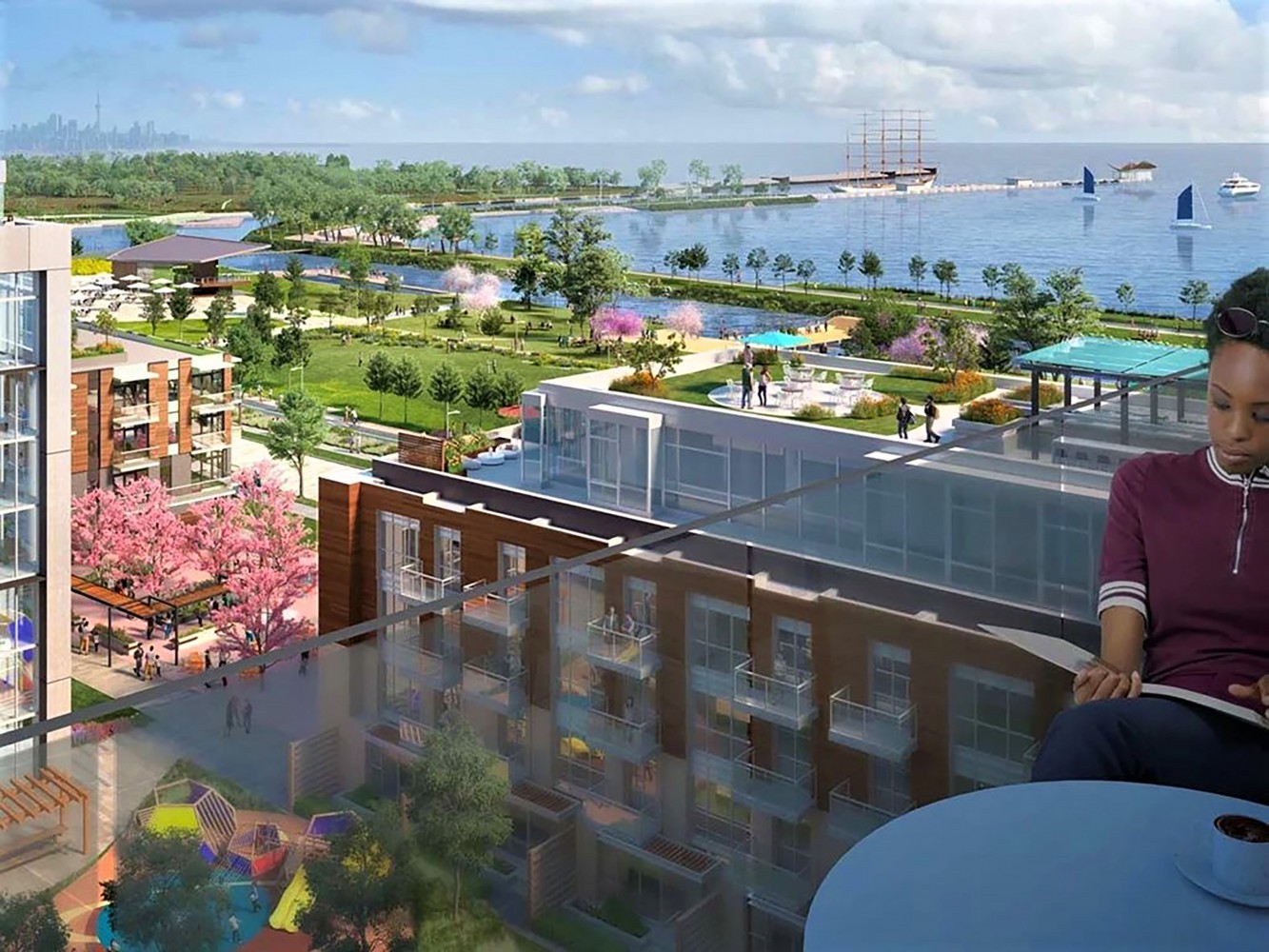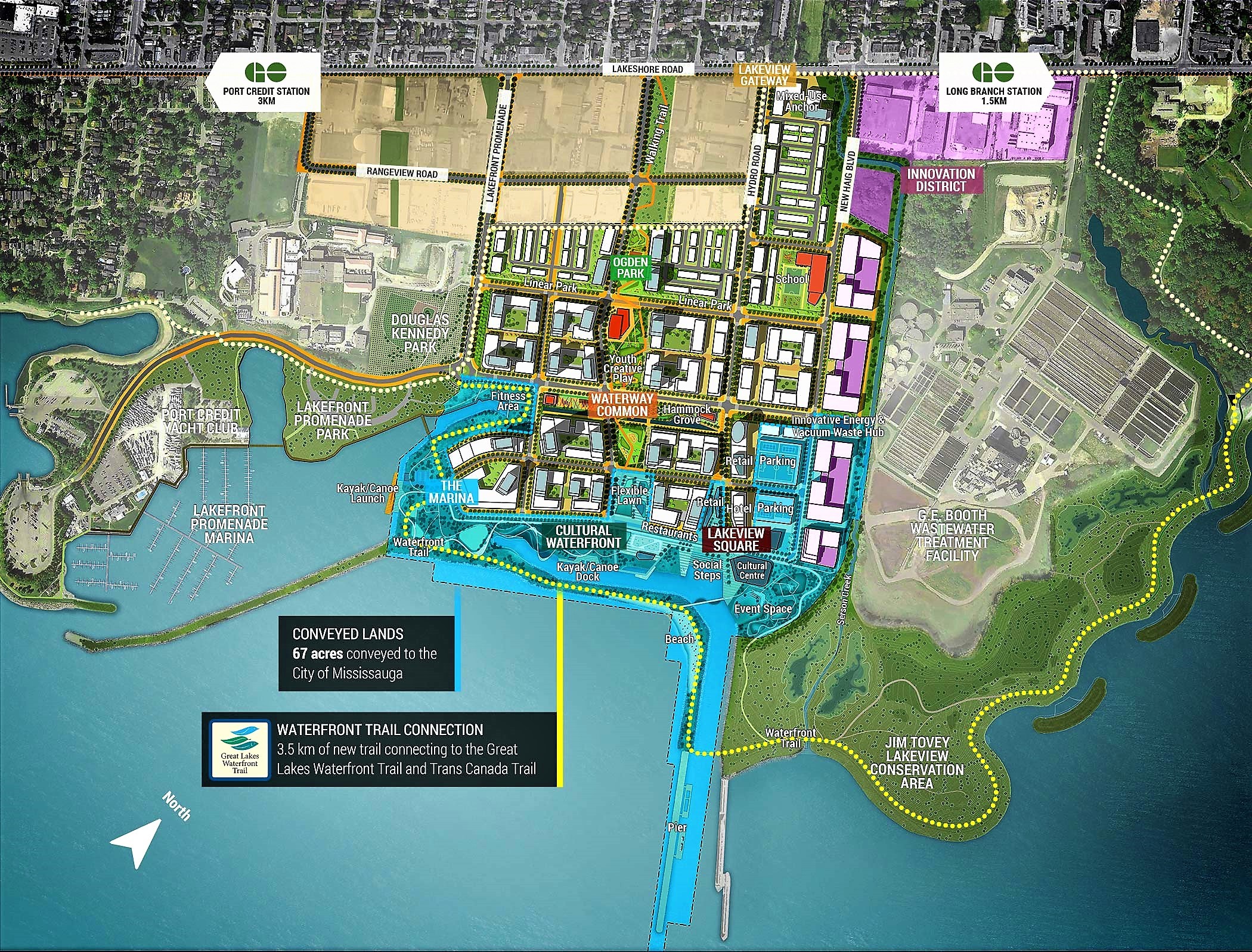
Peel residents to pay $9.5M for odour mitigation at Mississauga wastewater plant next to giant lakefront development
The completion of Lakeview Village will be a watershed for Mississauga’s waterfront.
The giant mixed-use community will be one of the first practical examples of City Hall’s vision for future growth — green, dense, walkable, vibrant, clean. A quantum leap for the property previously home to a smog-spewing, coal-fired power generating station, known around Mississauga as the Four Sisters.
The squeaky clean image for Lakeview Village is something the development consortium behind the project, Lakeview Community Partners (LCP), has worked hard to cultivate, not only to keep City officials behind the project, but also to motivate potential buyers of the 8,000 residential units that will be erected on the property in the years ahead. LCP purchased the 177-acre piece of prime real estate — previously owned by Ontario Power Generation, a public entity — for the bargain-basement price of $275 million in 2018.
The sometimes vile smelling G.E. Booth Wastewater Treatment Plant that sits immediately next door, a stone’s throw from the eastern edge of the massive project, is the last thing LCP wants people thinking of when their minds turn to Lakeview Village.

A map shows the close proximity of the Lakeview development to the G.E. Booth Wastewater Facility.
(Graphic from City of Mississauga)
However, on certain days, the odour can be hard to ignore, and with the proximity to the Lakeview property, it will be hard to escape for future residents and visitors without proper mitigation measures.
It’s a mess LCP could have easily avoided. The initial plan for the project, known as Inspiration Lakeview, called for a 150-metre buffer between the wastewater plant and any future residential development, a minimum distance recommended by the Province, that could have assisted with many odour issues faced by future residents. Instead, LCP ignored that buffer when the development consortium forged ahead with its own, taller, denser vision for the property—at odds with what area residents were calling for and what Mississauga Council initially approved—and pushed the future development 30-metres closer to the facility.
It has created significant issues around the surrounding odour in the process.
According to an assessment submitted to the City of Mississauga by the development group, Lakeview Village will be nearly 300 metres closer to the wastewater treatment facility than any other current residential units. The report states that the next closest property is a full 400 metres from the treatment facility’s borders. “Significant odour issues” were observed on the site, the report states.
To mitigate the issue, an agreement between the Region of Peel, which handles wastewater services for Mississauga, and LCP was forged that sees the development consortium on the hook for only a fraction of the total cost. LCP is currently paying $366,000 in upfront costs to begin short-term odour mitigation measures at the facility, but the overall cost to the Region to solve the problem long-term will be approximately $190 million over the next decade.
“With long-term odour controls anticipated to be operational in 2026/2027, LCPL, in consultation with the Region, independently funded interim measures to reduce odour from the existing plant,” the developer told The Pointer. “Both the interim and long-term odour control measures will alleviate the condition which currently impacts many residents in southern Mississauga.”
While the lion’s share of the long-term cost, 95 percent, will be covered by development charges, residents will be covering 5 percent, or $9.5 million from utility rate charges.
LCP is made up of: Argo Development Corporation, TACC Construction Limited, Branthaven Homes, Greenpark Group and CCI Development Group of Companies.
“Odour concerns around the G.E. Booth Wastewater Treatment Plan were conveyed by local residents to Lakeview Community Partners Limited (LCPL) at Lakeview Village public meetings held during the planning process and were subsequently shared with Region of Peel staff,” the development group told The Pointer.
“LCPL supports the Region’s efforts to ensure that historical odour issues from G.E. Booth are properly addressed and mitigated to the benefit of current Lakeshore residents, the future Lakeview Village community and visitors to nearby greenspace and parks, such as the Jim Tovey Lakeview Conservation Area.”
The developer said “the vast majority” of the $190 million odour mitigation will be covered by development charges. “Development charges are routinely used by local and regional municipalities to ensure that growth pays for growth, and the development partners within LCPL have helped fund many other similar projects across the region through this mechanism.”
Development charges are typically covered by those who buy the residential and commercial units that are built, and when costs for projects increase, forcing higher fees that have to be paid to municipalities, they are usually passed on to buyers.
The G.E Booth Wastewater Treatment Plant (formally known as Lakeview WWTP) was constructed in 1961 and was designed to serve a community of 100,000 people or less. Odours emanating from the facility were never an issue before, as the only immediate neighbour for decades was the infamous Four Sisters smokestacks.
As Mississauga’s population continued to grow, upgrades to the system needed to be made as the Township of Toronto started incorporating more communities into the County of Peel. In 1974, when the Township of Mississauga became a city, adding Port Credit and Streestville, the wastewater facility served 334,753 Peel residents.
The photo above shows a very different time in the pre-Mississauga history and Port Credit circa 1949.
(City of Mississauga archives)

The vision of Lakeview Community Partners is a drastic shift for the city's waterfront.
(Cicada Design Inc./Lakeview Village)
The growth in population added pressure on the system and renovations were needed. Flash forward to the present and the facility treats 65.4 percent of the Region’s wastewater. The 3,709 kilometers of pipes served a population of 1.6 million in 2021.
According to John Glass, manager of water and wastewater operation and optimization for the Region of Peel, odours become more prominent the larger the intake of the plant.
“The Region has invested significantly in addressing odour control from structures and much of the infrastructure is housed indoor to address odour control,” he told The Pointer in an email.
Where the G.E. Booth plant was constructed made sense in the late 1950s, as the facility sits on Lake Ontario where the wastewater is sent after it’s treated. The modern goal of reclaiming prime property, like former industrial lakefront, and turning these old brownfield sites into livable spaces, is at odds with the infrastructure of the past.
The G.E. Booth facility receives a handful of smell complaints every year, about 10, most of which relate to specific circumstances and particular days when a range of conditions, such as wind patterns and air quality, conspire to create foul odours. In 2020 there were four complaints, and 2021 saw six as of mid-December.
Glass told The Pointer the Region has always had a desire to eliminate odours emanating from the plant even before Lakeview Village was envisioned.
“The Region has increased its focus on addressing plant and collection system related odours significantly in the last decade and will expand this focus during upcoming expansions,” Glass said.
A regional spokesperson told The Pointer the work required over the next 10 years is a direct result of the Lakeview Village project and the decisions by LCP, but all Peel residents could stand to benefit.
“A significant portion of the $190 million for odour management is a result of the Lakeview development,” the spokesperson stated. “However, there is a benefit to all neighbouring communities.”
In the Spring of 2020, a Regional staff report detailed how LCP would finance interim odour measures while Peel outlined a plan and funds for a more permanent solution.
The interim solution includes adding an odour control system to Plant 1, the oldest part of the facility which is undergoing renovations currently. Adding to the scope of work already being completed allows the Region to extend contracts with the workers and start implementing odour measures immediately. The cost of the work including design, construction and permits is $366,000, all of which will come out of the pockets of LCP.
The oldest part of the facility directly faces Lakeview Village allowing offensive smells to seep into the noses of residents.
(Region of Peel)
Until the smell is completely removed, the residential blocks closest to the waste facility will have a holding label, meaning they cannot be constructed until the issue is resolved.
“In the old days when I was growing up, depending on which way the wind blew you kind of knew which area of town you're in,” Ward 1 Councillor Stephen Dasko, whose constituency includes the Lakeview lands, told The Pointer.
The wastewater facility is undergoing construction to create more capacity.
(Region of Peel)
In order for the recent mitigation agreement to take place, the Region increased financing on existing contracts with CIMA Consulting and Romag Construction for the design and build. Due to the pandemic, the Region opted to slowly roll out the measures while LCP paid for immediate action.
Regional staff believe amending existing contracts with workers on the site currently can save Peel money in the long run.
“Undertaking preliminary design and construction to support the odour control strategy under current design and construction assignments will reduce future engineering and construction costs,” a report from staff stated.
A huge portion of the project will be funded through development charges (DCs) but it’s unclear when LCP will be in a position to hand over the lion’s share of the $190 million.
The City of Mississauga collects the DCs on behalf of the Region and does so each time a building permit is triggered. The appropriate amount of fees are then distributed to Peel Region to cover costs for those pieces of public infrastructure that are in its jurisdiction.
The recommendations from the study included covering and treating “odorous air” with clarifying tanks, building systems to collect and treat smells during maintenance and constructing specific odour control measures for certain processes in the treatment of wastewater.
According to Councillor Dasko, the most odorous times of the year occur during the hot, humid summer months when workers need to clean out the ash lagoons at the facility. The long-term plan to renovate the facility eventually will see the removal of the open ponds.
Half the measures will take place by 2026 to fit with the development timeline for Lakeview Village.
Of the $471.5 million wastewater capital project, Peel’s 2022 budget allocates $251 million for various restoration, rehabilitation and odour control projects for the G.E Booth facility. In 2022 the budget allocates approximately $51.3 million towards the recommendations of the odour control study to design the renovations. A new odour control facility expense is lumped in with other capital improvements of the new addition to the facility already under construction, being allocated $78 million in 2022.
While there are some downsides to constructing a community within close proximity of a water treatment plant, LCP has hopes to use the wastewater facility to its benefit. There are plans to create a district energy system to centralize heating and cooling by using effluent water from the facility as a source of thermal heat for the development.
Creating the system will “require government funding beyond municipal resources” and timelines for making it a reality may not align with the development application, City staff fear. The same concern is true of an innovative plan for a vacuum waste disposal system, subject to a different timeline and further government funding.
In the meantime, it remains unclear what the potential smell from the adjacent facility will mean for future residents.
“Odour doesn't know one particular border,” Dasko told The Pointer. “So I thought if there's something that we can do to help the whole community, then it's worth putting our best foot forward.”
The Ward 1 Councillor sees the overall renovation and further measures as a “win for the community.”
Lakeview Village has the potential to be a gamechanger for Mississauga, as it continues its rapid, modern urbanization. How stakeholders manage the project will show the entire world the types of commitments to clean, green future-ready planning along the majestic waterfront of one of Canada’s most dynamic cities.
“LCPL is committed to building a future-ready, sustainable community,” the developer said.
Foul smelling odours wafting over the former industrial lakefront now being developed for community living, are an early challenge to the promise of Lakeview Village.
Email: [email protected]
Twitter: @taasha__15
COVID-19 is impacting all Canadians. At a time when vital public information is needed by everyone, The Pointer has taken down our paywall on all stories relating to the pandemic and those of public interest to ensure every resident of Brampton and Mississauga has access to the facts. For those who are able, we encourage you to consider a subscription. This will help us report on important public interest issues the community needs to know about now more than ever. You can register for a 30-day free trial HERE. Thereafter, The Pointer will charge $10 a month and you can cancel any time right on the website. Thank you
Submit a correction about this story


